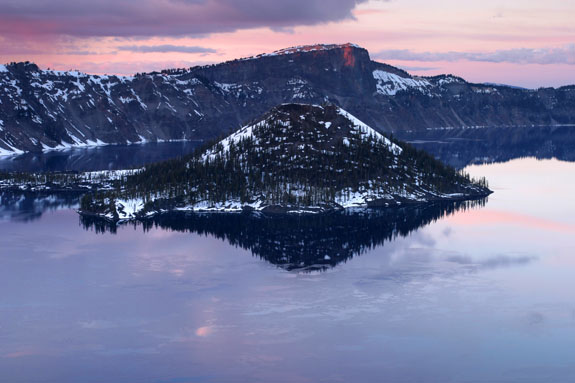Nature Notes by Dr. Frank Lang
Crater Lake is one of planet Earth’s great scenic wonders. 7,700 years ago, or so, a former mountain of considerable height had an accident. It blew up, then down. In the process it scattered ash, pumice and hot rocks all over, then collapsed in upon itself. Mount Mazama, 12,000 feet or so tall, became a caldera, a basin-shaped volcanic depression that eventually filled with water to become Crater Lake. Today, a 1,932-foot deep lake of indescribable blue occupies the six-mile diameter caldera.
Crater Lake National Park was created almost 100 years ago, so that people like you and me could enjoy its considerable natural beauty. When I think of Crater Lake I think of certain animals and plants: the golden-mantled ground squirrel, Clark’s nutcracker, and the pumice moonwort. There are others, but for me they are Crater Lake.
At first glimpse, many people think golden-mantled ground squirrels are chipmunks. Although both have stripes along their sides, golden-mantled ground squirrels have a pronounced eye-ring instead of stripes along their heads as chipmunks do. Most park visitors encounter these little beggars along the rim. They are fat, as they should be to make it through the winter when tens of feet of snow cover their nests in average years. Their normal varied diet includes insects and green vegetation besides seeds, fruits and nuts. Rim rodents eat like park visitors, however. Their diet consists of junk food fed to them by visitors — popcorn, Cheez-Its, and balloon bread, in spite of the objections of the Park Service.
Clark’s nutcrackers are noisy, black and white and gray crow-sized birds. They fly about the rim in and out of mountain hemlock, fir and whitebark pine. They are an alpine species thought by many to be a major agent in the migration of alpine tree species. Clark’s nutcrackers are hoarders and cachers of conifer seeds. They hide away as many as 30,000 seeds in late summer and fall in the soil of warmer, south-facing slopes. They can carry up to 95 pine seeds per trip. To survive they must recover at lest 1,000 caches a year. Amazingly, nutcrackers do this by means of a prodigious spatial memory, as ornithologists have shown. They disperse and bury two to three times as many seeds as they eat in a season. They don’t get or need them all. Rodents sometimes benefit instead, and certainly the tree species involved, as well.
The inches-tall pumice moonwort produces spores in sporangia arranged in tiny grape-like clusters. For many years the plants were known from Newberry Crater and the Three Sisters area, always in pumice-rich soils. Fifteen thousand individuals are known, all in Oregon, a real native.
When you visit Crater Lake be sure to stop by the Crater Lake Natural History Association sales are at the headquarters building on the way to the rim or at their shop at the rim. At this point they don’t know if they will be in a trailer at the rim or in their usual spot in the small Kaiser building near the rim viewpoint because of construction plans. Like all National Park Cooperating Associations they sell books and other items selected to help the visitor learn more about the park and the natural world. No rubber tomahawks and colored turkey feathers here. Besides that, all the profits go directly back to the park to aid in their interpretive programs or for park research projects.
— Dr. Frank Lang
 |
| Wizard Island (foreground) and Llao Rock (background), Crater Lake National Park, photo by Robert Mutch |

